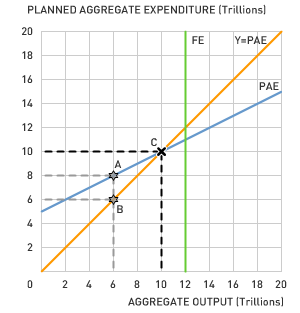Sticky Prices and the Xbox 360
by William Chiu If you recently tried to purchase an Xbox 360 at the retail price of $300, then you were probably out of luck. Every retailer in the United States is completely sold out of the console, and retailers have no idea when they will have the console back in stock.
If you recently tried to purchase an Xbox 360 at the retail price of $300, then you were probably out of luck. Every retailer in the United States is completely sold out of the console, and retailers have no idea when they will have the console back in stock.Shortages should cause prices to rise, but the market price of a Xbox 360 debuted at $300 and has stayed there (despite shortages). Microsoft is responding to the shortage by producing more Xbox 360's rather than raising prices.
A Keynesian economist is not surprised by Microsoft's short-run behavior. Let's examine the effects of sticky prices on the macroeconomy if every firm behaved like Microsoft. The graph on your right shows the Keynesian model, or the short-run macro model. Suppose the economy is producing $6 trillion worth of output, a level below the equilibrium output. Notice that when output equals $6 trillion, planned aggregate expenditure equals $8 trillion. In other words, planned spending exceeds output. According to the Keynesian model, prices are sticky, hence firms respond to excess demand by raising output, not raising prices.
Firms like Microsoft will raise output until planned aggregate expenditures equal aggregate output.
Notice that the short-run equilibrium output need not be at full employment output (FE).
1. If prices are sticky and the economy is operating below its full employment output (or potential output), what policies should the Fed and Congress pursue?
2. What causes prices to be sticky? Readings on the possible causes: Tim Harford and Alex Tabarrok
3. What happens to prices if the economy is below its full employment output for 6 months, 1 year, 2 years?
Professor Resource: PowerPoint Slides
Topics: Keynes, Keynesian model, Sticky prices
Labels: AD-AS Model



0 Comments:
Post a Comment
<< Home